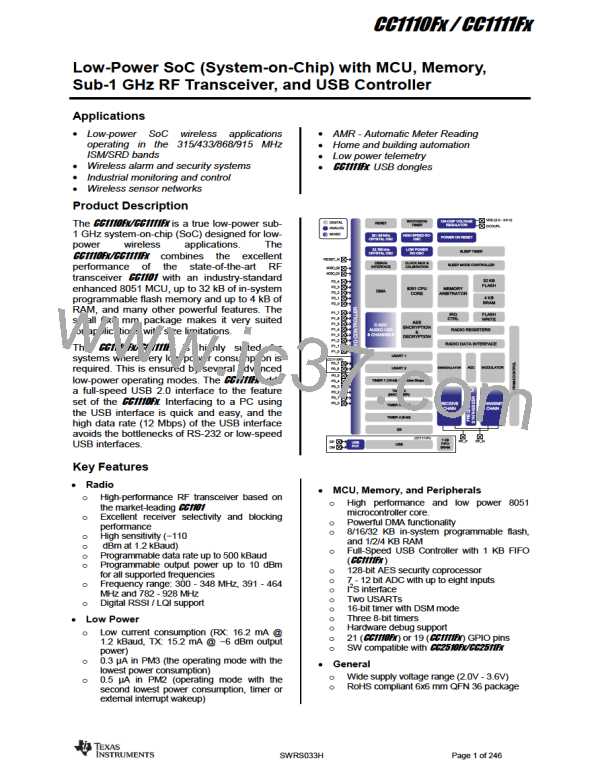CC1110Fx / CC1111Fx
RFST
Value
Command
Strobe
Description
Name
0x00
0x01
SFSTXON
Enable and calibrate frequency synthesizer (if MCSM0.FS_AUTOCAL=01). If in RX (with
CCA):
Go to a wait state where only the synthesizer is running (for quick RX / TX turnaround).
SCAL
Calibrate frequency synthesizer and turn it off. SCALcan be strobed from IDLE mode
without setting manual calibration mode (MCSM0.FS_AUTOCAL=00)
0x02
0x03
SRX
STX
Enable RX. Perform calibration first if coming from IDLE and MCSM0.FS_AUTOCAL=01.
In IDLE state: Enable TX. Perform calibration first if MCSM0.FS_AUTOCAL=01.
If in RX state and CCA is enabled: Only go to TX if channel is clear.
0x04
SIDLE
SNOP
Enter IDLE state (frequency synthesizer turned off).
No operation.
All
others
Table 61: Command Strobes
13.2 Radio Registers
The operation of the radio is configured
through a set of RF registers. These RF
registers are mapped to XDATA memory
space as shown in Figure 14 on Page 43 .
In addition to configuration registers, the RF
registers also provide status information from
the radio.
Section 10.2.3.4 on Page 50 gives a full
description of all RF registers.
13.3 Interrupts
There are two interrupt vector assigned to the
radio. These are the RFTXRX interrupt
(interrupt #0) and the RF interrupt (interrupt
#16):
issued, meaning that one can not write to the
RFDregister before issuing an STX strobe.
For an interrupt request to be generated when
TCON.RFTXRXIF
is
asserted,
RFTXRX: RX data ready or TX data
complete (related to the RFDregister)
IEN0.RFTXRXIEmust be 1.
Note: When append status is enabled,
PKTCTRL1.APPEND_STATUS=1, reading
status byte 1 (see Section 13.8) from the
RFDregister will trigger the assertion of the
RFTXRXIFflag for status byte 2. If this flag
is cleared AFTER reading status byte 1,
the new flag will be cleared as well. One
RFTXRXIF assertion will therefore be
missed by software. After assertion of the
RFTXRXIF flag one should therefore clear
the flag BEFORE reading the RFDregister.
RF: All other general RF interrupts
The RF interrupt vector combines the
interrupts shown in the RFIM register shown
on Page 190. Note that these RF interrupts are
rising-edge triggered meaning that an interrupt
is generated when e.g. the SFD status flag
goes from 0 to 1.
The RF interrupt flags are described in the
next section.
13.3.1
Interrupt Registers
13.3.1.2 RF
13.3.1.1 RFTXRX
There are 8 different events that can generate
an RF interrupt request. These events are:
The RFTXRX interrupt is related to the RFD
register. The CPU interrupt flag RFTXRXIF
found in the TCON register is asserted when
there are data in the RFD register ready to be
read (RX), and when a new byte can be written
(TX). In TX, the RFTXRXIF flag will not be
asserted before an STX strobe has been
TX underflow
RX overflow
RX timeout
Packet received/transmitted. Also used
to detect overflow/underflow conditions
SWRS033H
Page 188 of 246

 TI [ TEXAS INSTRUMENTS ]
TI [ TEXAS INSTRUMENTS ]